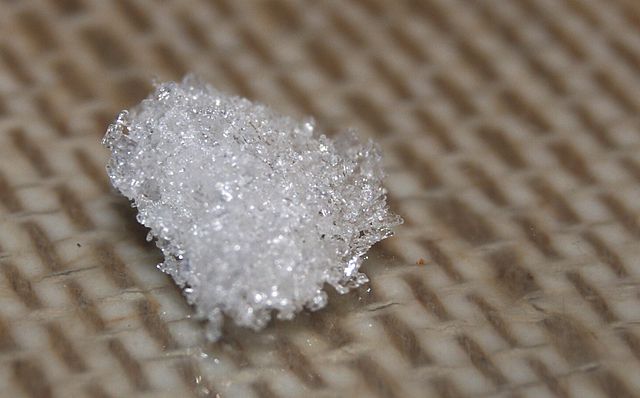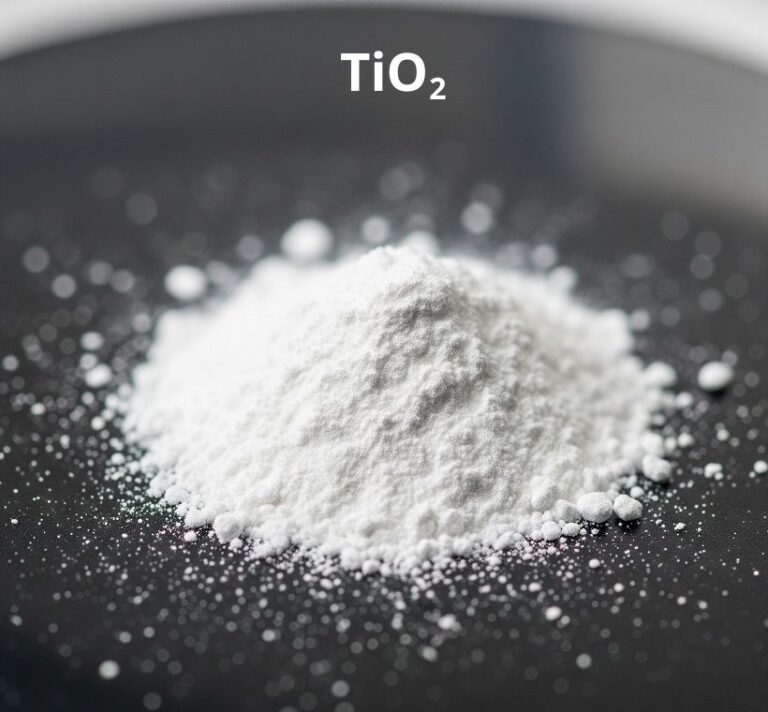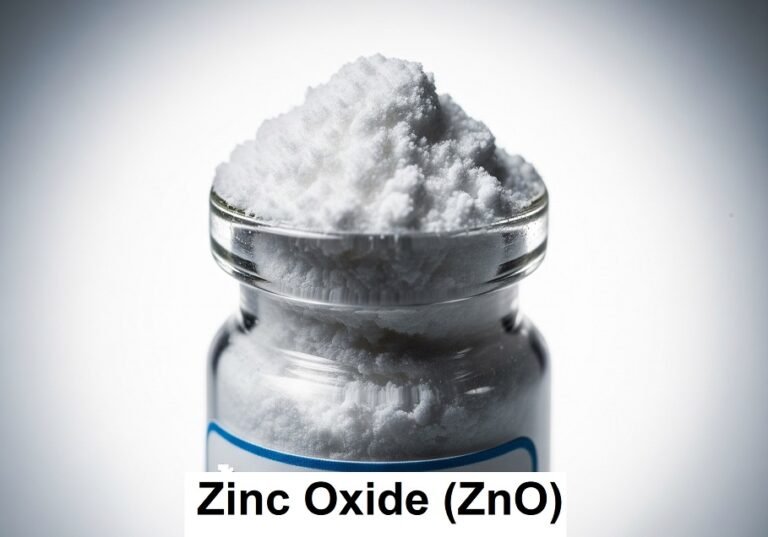
1. Anhydrous Aluminum Chloride
Hans Christian Oersted first prepared anhydrous aluminum chloride in 1825 by passing chlorine gas through a heated mixture of alumina and carbon. This compound is a significant catalyst in organic chemistry, particularly for Friedel-Crafts alkylation and acylation, which are used to produce alkylated aromatics, dyestuffs, pharmaceuticals, and perfumery chemicals.
Table of Contents
1.1. Physical Properties of Anhydrous Aluminum chloride
Aluminum chloride is found as a dimer Al2Cl6 at temperatures up to 400 °C. As the temperature increases, the dimer begins to dissociate, and at temperatures surpassing 800 °C, this dissociation becomes complete.
The solid form of aluminum chloride takes on a monoclinic layer lattice arrangement upon crystallization.
While pure aluminum chloride is white, the commercial variant often carries a yellowish or grayish hue due to trace amounts of iron chloride or aluminum impurities. The specific physical properties of anhydrous aluminum chloride are shown in the following table:
| Property | Value |
|---|---|
| Molar Mass | 133.34 g/mol |
| Density (ρ) | 2.44 g/cm³ |
| Sublimation Temperature | 181.2 °C at a pressure of 101.3 kPa |
| Triple Point | 192.5 °C at 233 kPa |
| Heat of Formation at 25 °C | -705.63 ± 0.84 kJ/mol |
| Heat of Sublimation of Dimer at 25 °C | 115.73 ± 2.30 kJ/mol |
| Heat of Fusion | 35.35 ± 0.84 kJ/mol |
| Heat of Solution at 20 °C | -325.1 kJ/mol |
1.2. Chemical reactions of Anhydrous Aluminum Chloride
Anhydrous aluminum chloride reacts vigorously with water to yield hydrogen chloride. This reaction leads to the formation of the hexahydrate AlCl3 • 6 H2O, with a molar mass of 241.44 g/mol.
In aqueous solutions, aluminum chloride undergoes partial hydrolysis, producing hydrochloric acid and aluminum oxychloride, denoted as AlClO. This behavior of aluminum chloride in aqueous medium underscores the challenges of isolating anhydrous aluminum chloride by solution concentration and hydrate calcination.
Heating aluminum chloride alongside γ-alumina results in the formation of aluminum oxychloride, AlClO. However, at temperatures exceeding 700 °C, this reaction reverses direction:
AlCl3 + Al2O3 ↔ 3 AlClO
Under specific conditions, vaporized aluminum chloride can react with molten aluminum at 1000 °C and reduced pressure, giving a volatile aluminum monochloride AlCl. This compound immediatly decomposes into its elemental constituents in the cooler sections of the reactor. Such a process has been harnessed for the purification of aluminum.
Reaction between aluminum chloride and various metal halides, such as CaCl2, CrCl3, and FeCl3, yields mixed halides. Eutectic melts, formed with other metal chlorides, are industrial important. For exemple, the eutectic melt formed with sodium chloride serves as a solvent in chlorination reactions.
Anhydrous aluminum chloride readily dissolves in polar organic solvents. Functioning as a Lewis acid, it engages in the creation of addition compounds with an array of electron donors. These include hydrogen chloride, hydrogen sulfide, sulfur dioxide, sulfur tetrachloride, phosphorus trichloride, ethers, esters, amines, and alcohols.
1.3. Production of anhydrous aluminum chloride
Anhydrous aluminum chloride can be produced from either aluminum or pure aluminum oxide. Bauxite is no longer used as a raw material because it contains iron chloride.
1.3.1. Chlorination of aluminum
The most common method for producing anhydrous aluminum chloride is by chlorinating molten aluminum. Chlorine is passed through the molten aluminum in a ceramic-lined reactor. The reaction is highly exothermic:
2 Al + 3 Cl2 → Al2Cl6 (ΔH° = -1411 kJ/mol)
The temperature in the reactor is maintained at 670–850 °C by controlling the flow rates of the chlorine and aluminum and by cooling the reactor walls with water. The aluminum is typically added in the form of lumps. The difficulty of controlling the large heat of reaction can be overcome by dividing the process into a number of small units.
The aluminum chloride vapor that leaves the reactor is passed through ceramic-lined tubes into large, air-cooled iron chambers. The solid aluminum chloride is withdrawn from the condenser walls at regular intervals, ground (to prevent moisture absorption), and classified by sieving. The chlorine in the off-gas is removed by conventional methods, such as absorption in caustic soda solution.
1.3.2. Chlorination of pure aluminum oxide
Chlorination of pure aluminum oxide is an alternative method for producing anhydrous aluminum chloride. This method is advantageous over the chlorination of aluminum because it produces a higher-purity product and avoids the high raw material costs of the chlorination of aluminum.
In the chlorination of pure aluminum oxide, carbon monoxide and chlorine are partially converted to phosgene over an activated charcoal catalyst. The gaseous reaction mixture then enters a brick-lined, fluidized-bed reactor, where it reacts with finely divided γ-alumina to yield aluminum chloride.
The reaction is exothermic enough (about 300 kJ/mol, based on AlCl3) to maintain the temperature at 500–600 °C without external heat. This allows for the use of large reactors and a long lifetime for the brick lining.
The aluminum chloride vapor is filtered through a bed of coarse pumice chips, condensed, and further processed as described above. The off-gas contains chlorine, phosgene, and large amounts of carbon dioxide.
The chlorine is removed by scrubbing, and the phosgene is hydrolyzed with water. Extremely pure aluminum chloride can be obtained by sublimation from molten sodium aluminum chloride.
1.4. Uses of anhydrous aluminum chloride
Anhydrous aluminum chloride is an important catalyst in the chemical and petrochemical industries. It is used in a variety of reactions, including:
- The alkylation of benzene by alkyl halides to form alkylbenzenes, which are used in the production of synthetic detergents.
- The liquid-phase ethylation of benzene with ethylene to yield ethylbenzene, which is used in the production of styrene.
- The production of ethyl chloride from hydrochloric acid and ethylene.
- The production of anthraquinone and its derivatives, which are used in the dyestuffs industry.
- The production of pigments, such as phthalocyanine green.
- The finishing of titanium dioxide pigments to protect them from oxidation.
- The reforming of hydrocarbons, as a polymerization catalyst in the production of hydrocarbon resins, and for the production of butyl rubber.
- The production of compounds, such as aromatic aldehydes, ketones, and 2-phenyl-ethanol, used in fragrances.
- The production of aluminum borohydride, lithium aluminum hydride, and compounds of phosphorus and sulfur.
Aluminum chloride solutions are also used as flocculating agents in the treatment of wastewater.
In addition to these uses, anhydrous aluminum chloride is also an intermediate in the production of aluminum by the Alcoa smelting process.
1.5. Toxicity and Handling
Anhydrous aluminum chloride is a corrosive and irritant substance that can cause damage to the skin, eyes, and respiratory tract. It is also a toxicant, and its toxicity is caused by the evolution of hydrochloric acid when it comes into contact with moisture.
Anhydrous aluminum chloride must be handled with care and in accordance with the relevant safety regulations. Personal protective equipment (PPE) such as goggles, gloves, and protective clothing must be worn when handling this substance. A fume cupboard or a respirator with a filter type B/St against acid gases should also be used.
Anhydrous aluminum chloride should be stored in a cool, dry place in tightly sealed containers. It should not be stored for more than six months, as it tends to cake. When transporting anhydrous aluminum chloride, it must be properly packaged and labeled in accordance with the relevant regulations.
The following safety precautions should be taken when handling anhydrous aluminum chloride:
- Avoid contact with the skin, eyes, and mucous membranes.
- Do not breathe the dust or vapor.
- Use a fume cupboard or respirator when working with this substance.
- Wash hands thoroughly after handling.
- Dispose of spills and waste properly.
2. Aluminum Chloride Hexahydrate
2.1. Properties of aluminum chloride hexahydrate
Aluminum chloride hexahydrate is a white, crystalline solid with the formula AlCl3·6 H2O. It has a hexagonal crystal structure and dissolves exothermally in water (133 g hexahydrate per 100 g water at 20 °C). The solubility increases only slightly with temperature. The aqueous solutions are strongly acidic because the salt hydrolyzes. Hydrogen chloride is evolved on heating concentrated solutions.
Here are some additional properties of aluminum chloride hexahydrate:
- Molar mass: 241.43 g/mol
- Density: 2.40 g/cm³
- Melting point: 100 °C (dec.)
- Hygroscopicity: Yes
- Odor: Faint odor of HCl
- Safety hazards: Corrosive, irritant, toxic
2.2. Production and uses of aluminum chloride hexahydrate
Aluminum chloride hexahydrate is produced by dissolving aluminum hydroxide in hydrochloric acid. The hexahydrate crystallizes when hydrogen chloride is passed into a cold (about 20 °C) saturated solution. This process removes impurities, such as iron(III) chloride.
Aluminum chloride hexahydrate is not widely used on its own, but it is an important intermediate in the production of aluminum oxide. It is also used in the production of photographic emulsions and as a flocculating agent in wastewater treatment.
Here are some additional informations about the production and uses of aluminum chloride hexahydrate:
- Production: Aluminum chloride hexahydrate is produced on a large scale by the Solvay process. In this process, aluminum hydroxide is dissolved in hydrochloric acid, and the resulting solution is then evaporated to dryness. The hexahydrate crystals are then separated from the solution.
- Uses: Aluminum chloride hexahydrate is used in the production of aluminum oxide, which is used in a variety of applications, such as the manufacture of aluminum metal, paints, and pigments. It is also used in the production of photographic emulsions and as a flocculating agent in wastewater treatment.
3. Basic Aluminum Chlorides
3.1. Properties of basic aluminum chlorides
Basic aluminum chlorides are a class of compounds with the general formula Al2(OH)6–nCln • xH2O. The individual compounds are best defined by their molar ratio of aluminum to chloride (2/n) or by their basicity, which is defined as (1 – n/6) × 100%.
The basicity of basic aluminum chlorides ranges from 30% to 75%. Compounds with a basicity of less than 30% are unstable and decompose to aluminum hydroxide and aluminum oxide on heating. Compounds with a basicity of more than 75% are stable in aqueous solution.
Basic aluminum chlorides are white, crystalline solids that are soluble in water. The solubility increases with the basicity of the compound. The electrical conductivity of aqueous solutions of basic aluminum chlorides is characteristic of the compounds.
Aqueous solutions of basic aluminum chlorides are acidic because the compounds hydrolyze. The stability of the solutions depends on the basicity of the compound.
Compounds with a basicity of less than 75% decompose to give insoluble basic aluminum chloride at a rate that depends on the temperature and concentration of the solution. Compounds with a basicity of more than 75% are very stable in aqueous solution.
When basic aluminum chlorides are evaporated, the compound Al2(OH)3.7Cl2.3 • 6.05 H2O (basicity 62%) always crystallizes. On addition of alkali to basic aluminum chlorides, aluminum hydroxide precipitates.
Hydrochloric acid converts all basic aluminum chlorides to the hexahydrate, AlCl3· 6 H2O.
3.2. Chemical structure of basic aluminum chlorides
Basic aluminum chlorides have been known for a long time, but only recently have investigations given significant insight into their chemical structures. Basic aluminum chlorides are mixtures of complex compounds of various degrees of polymerization.
Spectroscopic and kinetic investigations of basic aluminum chlorides and their solutions have led to the conclusion that the complex ion [Al13O4(OH)24(H2O)12]7+ is present and is in equilibrium with its polymeric forms.
The variations observed in the properties of these aqueous solutions, such as viscosity and pH, are caused by polymerization and depolymerization of the complex ion.
3.3. Production of basic aluminum chlorides
Basic aluminum chlorides are made by dissolving either aluminum hydroxide or metallic aluminum in hydrochloric acid. Aluminum hydroxide that has aged will only produce compounds with a basicity of up to 65%.
To obtain aluminum chlorides with a high basicity, freshly precipitated aluminum hydroxide must be used. However, the preferred method is to dissolve aluminum in hydrochloric acid, either thermally or electrochemically.
The thermal method involves heating a mixture of aluminum and hydrochloric acid. The reaction is exothermic, so the temperature must be carefully controlled. The resulting solution will contain aluminum chloride and water. The basicity of the solution can be increased by adding more hydrochloric acid.
The electrochemical method involves passing an electric current through a solution of aluminum and hydrochloric acid. This causes the aluminum to dissolve and form aluminum chloride. The basicity of the solution can be increased by adjusting the current or the amount of time the reaction is allowed to proceed.
The solid basic aluminum chlorides are obtained from the solutions by careful evaporation or by spray drying.
Recently, another method for producing basic aluminum chlorides has been developed. This method involves controlled thermal decomposition of AlCl3· 6 H2O.
3.4. Uses of basic aluminum chlorides
The uses of basic aluminum chlorides, including polyaluminum chlorides and aluminum chlorohydrate, are as follows:
- Polyaluminum chlorides with basicities from 35% to 60% are widely used as flocculating agents to purify water. They help clump impurities together, making it easier to remove them from water. PAC is used in treating surface water, sewage, industrial wastewater, and even in swimming pools.
- Polyaluminum chlorides serves as a fixing sizing agent in the paper industry. It helps make paper stronger and more resistant. This was especially important when moving from acidic to neutral or alkaline sizing methods, replacing traditional aluminum sulfate.
- Aluminum chlorohydrate, a specific type of basic aluminum chloride, is used in cosmetics, especially antiperspirants. It’s an important ingredient that helps reduce sweating. It needs to be very pure for this purpose.
- Catalyst Production and Fibers: Aluminum chlorohydrate has applications in producing catalysts and creating temperature-resistant fibers based on Al2O3. This extends its use to various industries that require these materials.
- Aluminum chlorohydrate serves as a hydrophobic agent in the impregnation of cotton textiles. It also contributes to leather tanning processes.
- In paper production, aluminum chlorohydrate acts as a retention agent, helping to improve the quality of paper. It’s also used as a binding agent in the production of fire-resistant ceramic products.
- Aluminum chlorohydrate is used as a hardening agent for quickly fixing baths in the photographic industry. Additionally, it functions as a flocculant, helping to purify swimming pool water by clumping impurities for easier removal.
3.5. Toxicology
Aluminum chlorohydrate is generally considered to be non-irritating to the skin in the concentrations used commercially.
However, the intermittent application of 150 mg of aluminum chlorohydrate over a period of 3 days had caused mild skin irritation in humans.
In comparison, a dose of only 7.5 mg of AlCl3·6 H2O (another type of basic aluminum chloride) caused the same degree of irritation.
Overall, the available evidence suggests that aluminum chlorohydrate is generally safe for use in cosmetics. However, it is important to note that some people may be more sensitive to this compound than others.
Reference
- Aluminum Compounds, Inorganic; Ullmann’s Encyclopedia of Industrial Chemistry. – https://onlinelibrary.wiley.com/doi/10.1002/14356007.a01_527.pub2



